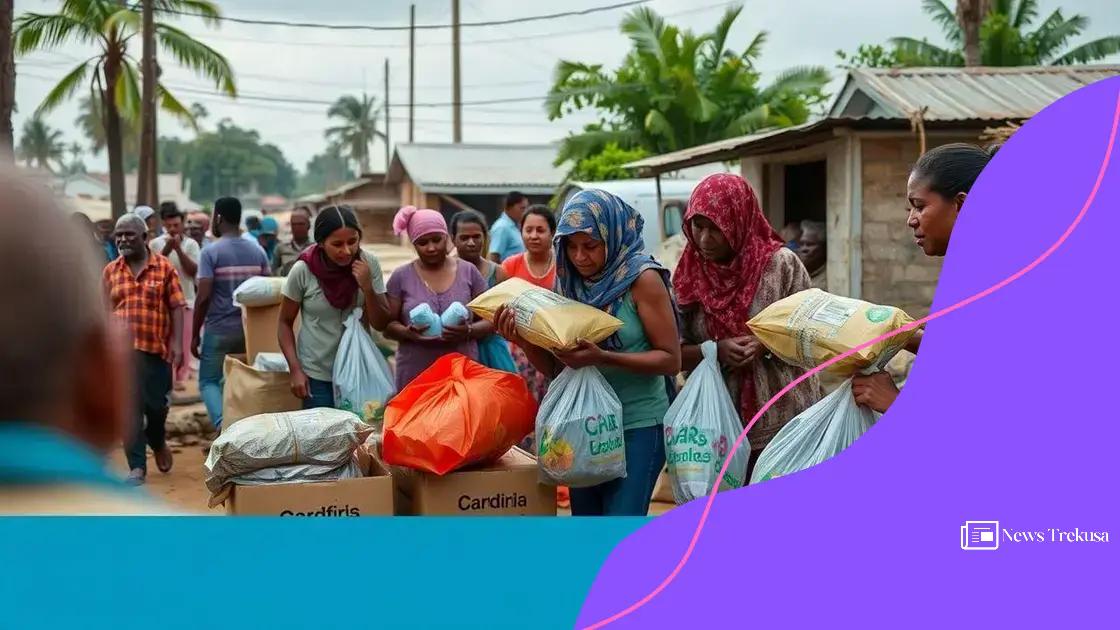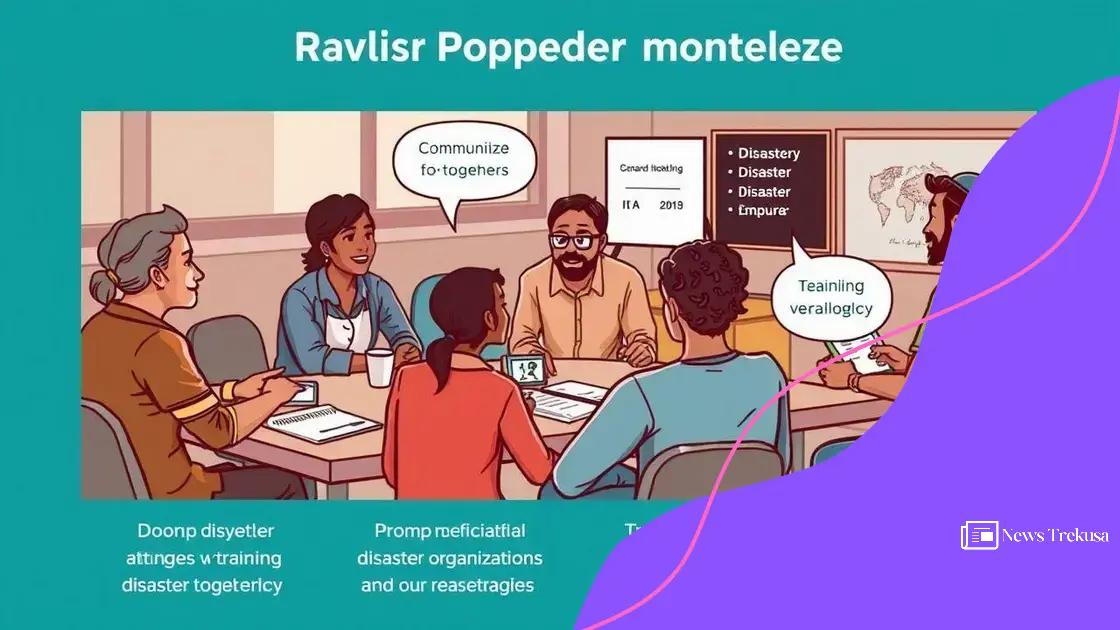Natural disaster relief efforts: how communities can unite

Natural disaster relief efforts rely on thorough preparedness and resilience strategies, including emergency planning, community support, and infrastructure investment to ensure effective response and recovery.
Natural disaster relief efforts play a crucial role in helping communities recover after a crisis. Have you ever wondered how these initiatives come to life? Let’s explore the various ways communities band together in the aftermath of disasters.
Understanding the impact of natural disasters
Understanding the impact of natural disasters is vital for communities. These events can disrupt lives and destroy property in a matter of minutes or seconds. Each disaster leaves deep scars on the affected areas, both physically and emotionally.
Types of Natural Disasters
Natural disasters come in many forms. Recognizing these variations is the first step in understanding their impacts:
- Earthquakes: Sudden shakes can cause buildings to collapse and lead to significant loss of life.
- Hurricanes: These storms bring heavy winds and flooding, devastating infrastructure and disrupting communities.
- Floods: Flooding can result from heavy rain or overflowed rivers, leading to water damage in homes and businesses.
- Wildfires: Fires can spread rapidly, destroying forests and residential areas, leaving ash and smoke in their wake.
The aftermath of these disasters can be overwhelming. Communities must rally to support each other during recovery. Psychological trauma can linger long after physical recovery, often affecting mental health. Support systems, including friends, family, and community organizations, become crucial.
Long-term Effects
Engaging in recovery efforts can also bring people closer together. After a natural disaster, residents often become more involved in local community initiatives. They may start preparing emergency plans, which helps build resilience against future incidents. This proactive approach lessens the long-term damage caused by disasters.
The financial impact is another critical concern. Families may struggle to pay for repairs or lost income after a disaster. Community resources, like relief funds and volunteer organizations, are essential to aid in rebuilding and recovery.
By understanding the multifaceted impact of natural disasters, communities can better prepare themselves for future challenges. Education and awareness are not just about immediate responses; they cultivate a culture of resilience that empowers individuals to thrive in adversity.
Key organizations involved in relief efforts
There are several key organizations involved in relief efforts that spring into action during and after natural disasters. These organizations play vital roles in supporting affected communities through various forms of assistance.
Major Humanitarian Organizations
Some of the most recognized humanitarian organizations provide immediate relief and long-term recovery:
- The Red Cross: Known for its emergency response and humanitarian aid, the Red Cross mobilizes volunteers and resources quickly.
- Doctors Without Borders: This organization focuses on providing medical care in crisis zones, helping those affected by illness or injury.
- UNICEF: UNICEF supports children’s needs during disasters, ensuring they have access to food, water, and protection.
- World Food Programme: This agency provides food assistance and helps communities rebuild food security after crises.
Beyond these major players, local organizations often have an essential role. These groups understand their communities’ unique needs and can mobilize resources effectively.
Governmental Agencies
Government agencies are also crucial during relief efforts. In many countries, organizations like FEMA (Federal Emergency Management Agency) in the U.S. coordinate disaster response at the federal level. They work with state and local governments to ensure that resources reach those in need.
These agencies manage shelters, distribute supplies, and conduct assessments to understand the immediate impacts of disasters. Their efforts help streamline recovery and rebuild infrastructure.
Collaboration between international organizations and local agencies enhances the effectiveness of disaster relief. By working together, these organizations can provide a more comprehensive response that addresses both immediate needs and long-term recovery.
Recognizing the roles of these organizations helps us understand how vital their work is in times of crisis. They embody the spirit of community and support, showing that when disaster strikes, we are not alone.
Strategies for community mobilization

Effective community mobilization is crucial during natural disaster relief efforts. By organizing resources and promoting collaboration, communities can respond more efficiently and support those in need.
Building Awareness
One of the first steps in successful community mobilization is building awareness. Organizing workshops and informational sessions helps residents understand the risks associated with disasters. Engaging local leaders to promote preparedness can foster a sense of responsibility.
- Communication: Establish clear channels for sharing information, such as community meetings, newsletters, and social media.
- Training: Offer training sessions on first aid and emergency response to empower residents.
- Resource Availability: Create lists of local resources, including shelters and medical services, and share them widely.
Another essential aspect is to encourage community participation. When people feel involved, they are more likely to take initiative and contribute during emergencies. Regularly involving residents in planning and training discussions strengthens their commitment.
Establishing Partnerships
Forming partnerships with local organizations also enhances mobilization efforts. Collaborations with schools, businesses, and nonprofit organizations can lead to more substantial support networks. These partnerships can provide additional resources and knowledge, making response efforts more effective.
Additionally, local governments play a vital role in mobilizing communities. By providing infrastructure and support, they enhance the community’s ability to respond to disasters.
During a crisis, having a coordinated response is essential. Community members should know their roles and understand how to work together. Exercises, such as disaster drills, allow them to practice and improve their readiness. An organized plan can save lives and minimize damages during disasters.
Utilizing technology can also aid in mobilization. Apps and platforms designed for emergency reporting allow residents to quickly share information about their needs. This ease of communication enhances community resilience.
Challenges in disaster response and recovery
Challenges in disaster response and recovery can significantly hinder efforts to support affected communities. Understanding these challenges is essential for developing effective strategies.
Logistical Difficulties
One major hurdle is logistics. Transporting supplies to hard-hit areas can become complicated, especially if roads are damaged. Additionally, coordinating deliveries among various organizations can create confusion.
- Communication Issues: Poor communication networks can delay the distribution of aid.
- Resource Allocation: Identifying where resources are most needed and ensuring they reach those locations can be challenging.
- Infrastructure Damage: Damage to critical infrastructure, like bridges and roads, can obstruct access.
These logistical issues often lead to delays in getting much-needed assistance to those who require it most.
Coordination Among Organizations
Another significant challenge is ensuring effective coordination among various organizations. Numerous groups may respond to a disaster, including government entities, NGOs, and volunteer organizations. When uncoordinated, efforts can overlap or conflict, wasting resources and time.
Establishing a clear command structure can alleviate some of these problems. Regular meetings and communication pathways should be established to streamline efforts. These practices help unify the response and improve efficiency.
Human factors can also complicate recovery efforts. Stress and trauma from disasters can cause emotional strain on survivors and responders alike. This can affect the overall effectiveness of those involved in relief efforts. Ensuring mental health resources are accessible is critical to helping individuals cope during recovery.
Financial Constraints
Funding is another significant challenge in disaster recovery. Organizations often depend on donations and government funding to support their activities. Economic downturns can lessen available resources, making it hard to carry out recovery programs.
Many communities struggle with long-term recovery and rebuilding after initial relief. Issues such as unemployment, housing shortages, and healthcare access can complicate efforts to restore normalcy. Continuous support from local and national governments is essential to navigate these challenges.
By recognizing and addressing these challenges, communities can better prepare for future disasters. Planning ahead can lead to improved strategies that mitigate these issues and enhance recovery efforts.
The importance of preparedness and resilience
The importance of preparedness and resilience cannot be overstated when it comes to responding to natural disasters. Being prepared means having a plan, resources, and knowledge to act quickly when a disaster strikes.
Creating Emergency Plans
An emergency plan is the backbone of preparedness. Families and communities should establish clear plans for what to do in case of different types of disasters. This includes evacuation routes, communication strategies, and meeting points.
- Family Communication: Designate a point of contact for family members.
- Emergency Kits: Assemble kits with food, water, and medical supplies.
- Practice Drills: Regularly conduct drills to practice your emergency responses.
These actions not only save lives but also help reduce panic during a crisis.
Building Community Resilience
Community resilience refers to the ability of a community to withstand and recover from disasters. Strong, interconnected communities are better equipped to face adversities. Communities can achieve this in various ways.
One way is through education and awareness programs. Communities should host workshops to educate their members about disaster risks and preparedness measures. Additionally, fostering relationships among community members builds trust and support systems. People who know their neighbors are more likely to check on each other and provide assistance during tough times.
Local leaders and organizations play critical roles in enhancing community resilience. They can create initiatives that encourage volunteerism and participation in recovery efforts. Supporting local businesses after a disaster also helps to maintain economic stability.
Investing in infrastructure improvements is another key aspect of building resilience. Ensuring that buildings, roads, and utilities are fortified against potential disasters reduces damage and recovery time.
In conclusion, enhancing preparedness and resilience in communities is a proactive approach to disaster management. The more prepared communities are, the more effective their response will be, resulting in safer and more resilient societies.
FAQ – Frequently Asked Questions about Preparedness and Resilience in Disaster Response
Why is having an emergency plan important?
An emergency plan helps families and communities know what to do during a disaster, reducing panic and ensuring safety.
How can communities build resilience?
Communities can build resilience by fostering strong relationships, creating support networks, and investing in local infrastructure.
What role do local organizations play in disaster preparedness?
Local organizations can educate citizens, provide resources, and coordinate community response efforts during and after disasters.
How can individuals contribute to disaster readiness?
Individuals can prepare by creating their own emergency kits, participating in community drills, and staying informed about potential hazards.
SEE MORE CONTENT